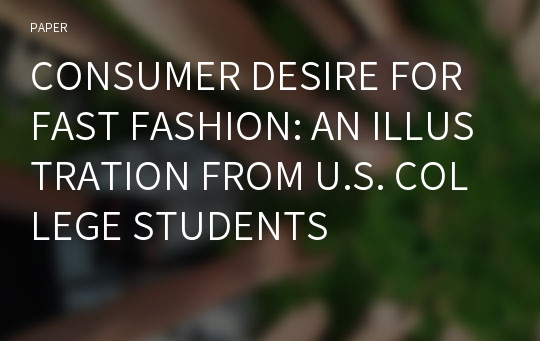CONSUMER DESIRE FOR FAST FASHION: AN ILLUSTRATION FROM U.S. COLLEGE STUDENTS
* 본 문서는 배포용으로 복사 및 편집이 불가합니다.
서지정보
ㆍ발행기관 : 글로벌지식마케팅경영학회(GFMC)
ㆍ수록지정보 : Global Marketing Conference
ㆍ저자명 : Nayeon Yoo, Hye-Young Kim
ㆍ저자명 : Nayeon Yoo, Hye-Young Kim
영어 초록
Introduction What is fast fashion? Does this term just define all the latest or the most popular or the most famous clothes? In reality, this social phenomenon goes beyond the conventional notion of industrialized fashion and carries more importance than is implied by this view. Fast fashion, defined as “the retail strategy of adapting merchandise assortments to current and emerging trends as quickly and effectively as possible” (Sull & Turconi, 2008, p. 5), has received a great amount of attention from fashion marketers and consumers since its inception during the 21st century (Tokatli, 2008; Jang et al., 2012). The purpose of this study was to deepen our understanding of fast fashion consumers. Based on the review of related literature, the key variables related to fast fashion consumers were categorized into three dimensions: consumer characteristics (i.e., fashion leadership, price consciousness), consumer awareness (i.e., awareness of sustainable practices of fast fashion retailers, perception of fashion democratization), and attitude toward fast fashion retailers. The three dimensions were examined in a sequential manner to assess the power of each set of antecedents in explaining college students’ repatronage intention of fast fashion retailers. Related Literature While fast fashion retailers have experienced a huge financial success mainly due to their affordable and accessible fashion products, they have also been harshly criticized by some members of the public because of their lack of corporate social responsibility. Indeed, fast fashion retailers’ low cost and efficient supply chain management systems have had negative effects on the environment, society, and people (Barnes & Lea-Greenwood, 2006; Bruce & Daly, 2006; Ro & Kim, 2009). The U.S. Environmental Protection Agency (EPA) announced that about 14.3 million tons of textiles were generated in 2012, making up 5.2 percent of total municipal solid waste. Such massive textile waste has been attributed to fast fashion retailers because the cheap and trendy items they produce encourage consumers to make frequent purchases and to frequently dispose of unwanted clothing. Furthermore, several fast fashion retailers (e.g. Gap and Forever 21) have been criticized for the use of child labor and the sweatshop-like conditions of their factories (Ramishvili, 2012). Moreover, some fast fashion retailers have been involved in intellectual property lawsuits because they replicated the runway designs of prominent designers to produce knock-off products (Pous, 2013). In response, a few fashion experts claim that fast fashion retailers destroy fashion because the styles produced lack of aesthetic expression and creativity (Choufan, 2013). However, these issues are not solely a problem associated with fast fashion retailers. In fact, the entire fashion industry is responsible for adverse environmental and societal consequences to some extent. Traditional fashion retailers (e.g. Diesel, Levi’s, Dolce & Gabbana, Chanel, Hermès) also generate huge amounts of textile waste along with hazardous waste that results from the chemical materials used in production processes. Their products are also manufactured in developing countries to keep production costs low. They also may not pay attention to the labor environment. Therefore, traditional fashion retailers along with fast fashion retailers have responsibilities related to sustainability issues (Casey, 2014; Greenpeace, 2013). Nevertheless, fast fashion retailers have received the majority of the public’s criticism regarding these issues. Contrary to a popular belief, fast fashion retailers have taken some steps to apply the concept of sustainability into their business practices. For example, H&M collects unwanted garments for recycling, uses recycled or reused materials for producing new garments and uses organic cottons (Lanyon, 2013). Other fast fashion retailers like Zara, Topshop and Uniqlo as well as H&M also have launched eco-friendly collections (MacDonald, 2012). Moreover, H&M, Zara, Mango and Uniqlo have committed to eliminate the release of toxic chemicals by 2020 in response to Greenpeace’s Detox campaign and to public pressure (Greenpeace, 2012). Furthermore, fast fashion retailers are also paying attention to labor issues. For instance, after more than 1,100 people died from the Rana Plaza building collapse on April 24th in 2013 (Chua, 2013), major fast fashion retailers signed the Accord on Fire and Building Safety in Bangladesh. This accord indicates these retailers agree to be responsible for the working environment for employees in apparel factories in Bangladesh. Although their ultimate goal might be to increase their sales by recovering their brand images damaged by unfavorable media coverage, it is clear that movement toward sustainable practices will minimize the negative impact of their business practices on the environment and society and encourage other retailers to incorporate sustainable practices. In spite of the harsh criticism directed at fast fashion retailers, consumers still like wearing fast fashion products considering that fast fashion retailers have continuously expanded their businesses worldwide and have been successful. Prior researchers interested in fast fashion retailers have focused on supply chain management issues (Barnes & Lea-Greenwood, 2006; Mihm, 2010), the value of fast fashion (Cachon & Swinney, 2011), and indentifying business strategies of a particular fast fashion retailer (Ferdows, Lewis, & Machuca, 2005; Ghemawat, Nueno, & Dailey, 2003; Tokatli, 2008). However, few researchers have theoretically explained why consumers still like fast fashion products and visit fast fashion retailers. With that in mind, the present study identified various factors that positively influence consumer attitude and their patronage intention toward fast fashion retailers. Furthermore, although fast fashion retailers have positive motivations toward consumers (e.g. provide inexpensive fashionable items,participate in sustainable practices), consumer research has highlighted their negative effects on the environment and society (e.g., Morgan & Birtwistle, 2009). Methods An online self-administered survey methodology was employed with a purposive sample of U.S. college students who had shopped at fast fashion retailers. A total of 154 usable responses were used for data analysis. The click through rate was 79.79%. Exploratory factor analysis and hierarchical regression were used to examine the interrelationships among the three dimensions of antecedents (consumer characteristics, consumer awareness, consumer attitude) and repatronage intention. The measurement items employed were developed based on previous literature. All items were reviewed and modified to fit the context of this research: consumer attitude and patronage intention toward fast fashion retailers (Madden, Ellen, & Ajzen, 1992); perception of fashion democratization (PFD) (Dubois, Czellar, & Laurent, 2005); fashion opinion leadership (Flynn et al., 1996; Goldsmith & Hofacker, 1991); and price consciousness (Lichtenstein et al., 1993). The items for measuring awareness of sustainable practices of fast fashion retailers (ASP) were created based on news articles presenting sustainable practices fast fashion retailers actually engaged in. Participant Characteristics Among the participants, 48.1% were majoring in a fashion related area (e.g. fashion design, retail merchandising). The majority of the participants were female (85.1%). Most participants (92.2%) were between 18 and 25 years old. With respect to ethnicity, 63.0% were Caucasian. Approximately half of the participants (52.6%) reported that they earned less than $10,000 annually. Also, 26.0% of the participants shopped at fast fashion retailers once a month. Results A weighted least squares (WLS) hierarchical regression analysis was used for data analysis. Fast fashion shopping frequency was used as a weight variable as it is related to the variability in the dependent variable. The results revealed that: (a) fashion leadership positively influenced repatonage intention (Model 1); (b) after controlling consumer characteristics, PFD played a significant role in increasing variance explained in repatonage intention (Model 2) and (c) after controlling consumer characteristics and awareness, consumer attitude was found to be a significant predictor, partially mediating the linkages from fashion leadership and PFD to repatronage intention (Model 3). Implications and Conclusion Our findings suggest that fashion leadership plays an important role in the fast fashion market because it initiates the acceptance of new trends and leads to diffusion of new fashion. Prior research suggests that fashion leaders (versus followers) are willing to take risks in trying new items offered by fast fashion retailers, are interested in fashion information, tend to retain fashion items for socializing for a short period of time and need various and unique fashion items (Goldsmith, Freiden & Kilsheimer, 1993; Kang & Park-Poaps, 2010). Given that fast fashion retailers promote frequent purchases and decrease the financial burden by offering new products on a weekly basis and charging low prices, our finding is consistent with fashion leaders’ characteristics prior research identified. Another important finding is that the role of PDF in defining fast fashion consumers. Fast fashion products look similar to high-end products, but are comparatively inexpensive because the fast fashion retailers apply or copy high-end designs into their products and use cheap materials (Niinimäki, 2009; Reinach, 2005). Also, fast fashion retailers open tremendous stores across the world, which make fashion more accessible to consumers globally. As a result, fast fashion retailers accelerate the fashion democratization and it means that both concepts of fast fashion and fashion democratization are highly related. As Wang (2010) stated, “fast fashion’s soul is to make fashion democratized with its low price and speed” (p.10). Further research is needed to extend and corroborate the findings of this study.참고 자료
없음태그
"Global Marketing Conference"의 다른 논문
 THE ROLES OF GREEN PACKAGING IN UGLY FOOD PURCHASE INTE..22페이지
THE ROLES OF GREEN PACKAGING IN UGLY FOOD PURCHASE INTE..22페이지 THE IMPACT OF INDUCED AWE ON ETHICAL TOURIST BEHAVIORS5페이지
THE IMPACT OF INDUCED AWE ON ETHICAL TOURIST BEHAVIORS5페이지 A BIBLIOMETRIC ANALYSIS OF SPIRITUAL TOURISM RESEARCH15페이지
A BIBLIOMETRIC ANALYSIS OF SPIRITUAL TOURISM RESEARCH15페이지 SOCIAL NETWORK ANALYSIS AND RESPONSE TIME TESTING: CONS..11페이지
SOCIAL NETWORK ANALYSIS AND RESPONSE TIME TESTING: CONS..11페이지 THE EFFECTS OF PARA-SOCIAL INTERACTION ON ONLINE CELEBR..3페이지
THE EFFECTS OF PARA-SOCIAL INTERACTION ON ONLINE CELEBR..3페이지 THE INFLUENCE OF OPINION LEADERS ON DAILY DEALS USER’S ..3페이지
THE INFLUENCE OF OPINION LEADERS ON DAILY DEALS USER’S ..3페이지 HOW IMMERSIVE RETAILING AFFECTS CONSUMERS’ URGE TO BUY:..6페이지
HOW IMMERSIVE RETAILING AFFECTS CONSUMERS’ URGE TO BUY:..6페이지 KEY TO SUPERSTARDOM IN A GLOBALISED MARKET: THE ROLE OF..6페이지
KEY TO SUPERSTARDOM IN A GLOBALISED MARKET: THE ROLE OF..6페이지 A POST-PANDEMIC LOOK AT TOURISTS’ PERCEIVED COOLNESS OF..4페이지
A POST-PANDEMIC LOOK AT TOURISTS’ PERCEIVED COOLNESS OF..4페이지 EXTRACTING OFFLINE RETAIL SHOPPING PATTERNS: OLLABORATI..5페이지
EXTRACTING OFFLINE RETAIL SHOPPING PATTERNS: OLLABORATI..5페이지


























